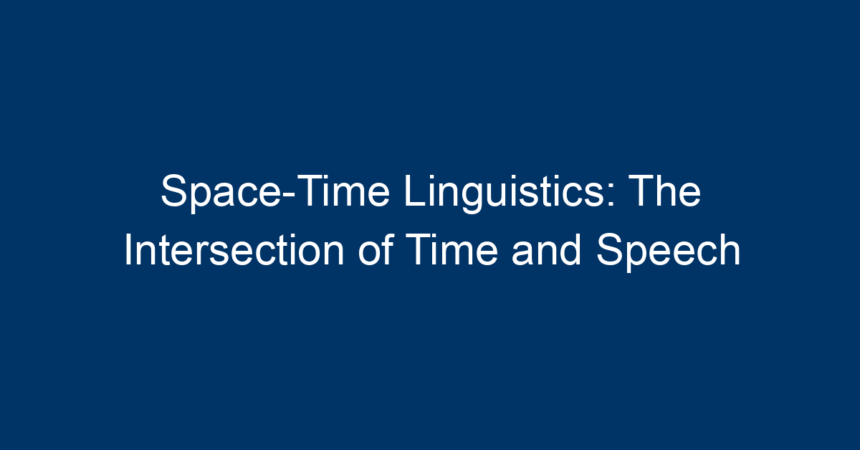Introduction
Space-time linguistics represents a fascinating intersection of two seemingly disparate realms: the universality of time and the nuanced complexity of human language. As we navigate our daily lives, we often overlook how our perceptions of time influence the way we communicate. This article delves deep into the concept of space-time linguistics, exploring how temporal elements affect speech patterns, language structure, and intercultural communication. By understanding this intersection, we can better appreciate the subtleties of both language and time, making us more effective communicators.
Understanding Space-Time Linguistics
Defining Space-Time Linguistics
At its core, space-time linguistics studies how our understanding of space and time shapes the language we use. Language is not a static entity; it evolves alongside human experiences, influenced by cultural contexts and temporal constructs. By examining this evolution, we gain insights into how communication operates across diverse societies and historical periods.
The Role of Time in Language
Time is a fundamental aspect of communication. Whether we’re recounting past events or speculating about the future, our sentences are often imbued with temporal markers. Verbs conjugate to reflect tense, adverbs indicate chronology, and contextual clues frame our discussions. In essence, the way we express time—through the choice of words, sentence structure, and even intonation—provides rich material for exploration in space-time linguistics.
The Relationship Between Language, Time, and Space
Temporal Markers in Different Languages
Different languages exhibit varying degrees of complexity in their treatment of time. For example, while English offers a simple past, present, and future tense system, languages like Mandarin Chinese use aspect markers to indicate ongoing actions. Spanish, on the other hand, employs multiple past tenses to emphasize different nuances of time, such as completion or habitual actions.
This distinction illustrates how cultural perspectives influence linguistic structures. Societies that prioritize historical narratives may develop richer past tense forms, while others may focus on immediate experiences, shaping their linguistic framework accordingly. This is a key aspect of space-time linguistics, highlighting the importance of temporal context in human expression.
The Impact of Space on Language
Space also plays a critical role in how we communicate. The manner in which we describe our environment affects our understanding of both physical space and temporal relationships. For example, in many Indigenous Australian languages, the orientation of speech is based on cardinal directions rather than relative position. This spatial awareness impacts not only how individuals describe their surroundings but also how they discuss future events.
Such spatial linguistic structures can influence cognitive processes, granting speakers distinct perspectives on reality. For instance, speakers of languages with elaborate spatial terminology may exhibit heightened navigational skills, showcasing the powerful connection between language, thought, and physical space.
Cognitive and Psychological Dimensions of Space-Time Linguistics
How Time Shapes Thought
The widely-studied Sapir-Whorf hypothesis posits that the language we speak influences our thoughts and perceptions of reality. This theory supports the idea that the temporal and spatial structures inherent in our language can shape cognitive patterns. For example, speakers of languages with a rich temporal structure may have a heightened awareness of time and its implications, resulting in a more sophisticated understanding of history and future possibilities.
Research indicates that individuals who speak languages with varying temporal frameworks exhibit different cognitive processing styles. This insight is crucial for space-time linguistics, as it underscores the links between language, cognition, and cultural context.
Psychological Effects of Language on Time Perception
Additionally, our use of language can alter our perception of time itself. Phrases like "time flies" or "in the blink of an eye" suggest an acceleration of time, while others, like "waiting forever," can invoke the feeling of time stretching. Such linguistic expressions influence our psychological experience of time and can affect our mood, decision-making, and overall well-being.
This psychological interplay highlights the importance of being mindful of the language we use when discussing time. By utilizing language that conveys a positive temporal experience, we can enhance our emotional resilience and improve communication in both personal and professional contexts.
The Cultural Significance of Time in Language
Temporal Norms and Communication
Cultural attitudes toward time dictate how communities approach scheduling, punctuality, and event planning. For instance, cultures that prioritize time (like Western societies) often view punctuality as a sign of respect, leading to conversations framed around schedules. In contrast, cultures with a more fluid sense of time, such as many Latin American or African cultures, may approach events with greater flexibility, valuing relationships over strict adherence to schedules.
Understanding these cultural differences is vital for effective communication across cultures. Awareness of space-time linguistics can enable individuals to navigate conversations with empathy and adaptability, creating a more harmonious exchange of ideas and intentions.
Case Studies in Space-Time Linguistics
Several interesting case studies illustrate the principles of space-time linguistics in action. For example, research among the Hopi tribe revealed that their language lacks certain temporal markers found in English. Despite this, Hopi speakers have profound cognitive abilities related to time, emphasizing the fluidity of human experience beyond linguistic constraints.
Another study examined how different cultures use metaphors for time. While English speakers often conceptualize time spatially (e.g., "looking forward" to the future), some cultures view it as cyclical. These variations not only affect language structure but also influence social interactions, expectations, and even business practices, highlighting the need for cultural competency in global communication.
Actionable Insights for Effective Communication
Embrace Temporal Nuances
To leverage the principles of space-time linguistics in daily interactions, be conscious of time-related nuances in language. Use temporal markers thoughtfully to express clarity and intent. Whether in casual conversations or business settings, precise language can enhance understanding and reduce miscommunication.
Foster Cultural Sensitivity
In an increasingly globalized world, cultural sensitivity is paramount. Develop an awareness of how different cultures perceive and express time. Adapt your language and communication style based on the cultural context, ensuring that your interactions are respectful and effective.
Practice Mindful Communication
Finally, be mindful of the psychological implications of language. Use expressions that enhance optimism and clarity, contributing to a positive perception of time. Encouraging phrases can foster a collaborative atmosphere, whether in team meetings, classroom settings, or personal relationships.
Conclusion
Space-time linguistics opens a window into the intricate relationship between language, time, and culture. It invites us to reflect on how our communication shapes—and is shaped by—our perceptions of time and space. By understanding this powerful intersection, we can enhance our communication skills, respect cultural nuances, and build deeper, more meaningful connections with others.
Incorporating the principles of space-time linguistics into our interactions empowers us to navigate linguistic landscapes more effectively, ultimately enriching our personal and professional relationships. Embrace the insights of space-time linguistics and watch as your understanding of language and communication evolves.




